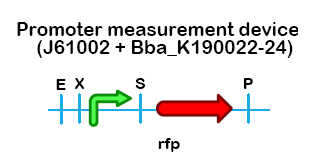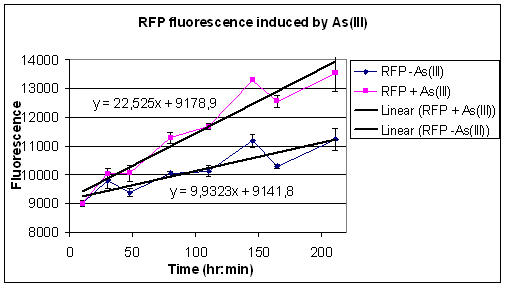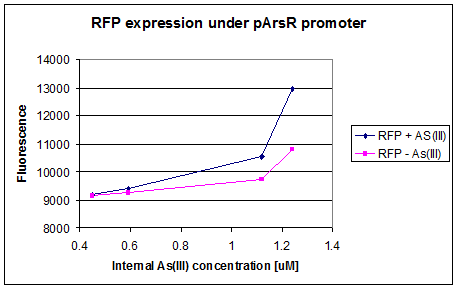Team:Groningen/Project/Promoters
From 2009.igem.org
(→cloning strategy) |
(→Results) |
||
| Line 59: | Line 59: | ||
:Figure 1: The promoter testing device in J61002, where RFP expression is under control of the promoter which is placed in front of it. | :Figure 1: The promoter testing device in J61002, where RFP expression is under control of the promoter which is placed in front of it. | ||
| - | The fluorescence (and OD600) was measured as described in [ | + | The fluorescence (and OD600) was measured as described in [[Team:Groningen/Protocols#Fluorescence_measurement| protocols]]. Upon induction of the ArsR promoter the expression of RFP increased with a relative promoter unit of 2.3 (calculated according to formula 9 as described by [[Team:Groningen/Literature#Kelly2009|Kelly 2009]]). This induction of promoter activity was also found for other metal sensitive promoter (used in expression of MTs) (personal communication, Dr. D. Wilcox). The increase in fluorescence over time is shown in figure 2 and the fluorescence change due to a change in the internal as(III) concentration in figure 3. |
[[Image:Fluorescence over time.PNG]] | [[Image:Fluorescence over time.PNG]] | ||
Revision as of 14:53, 21 October 2009
[http://2009.igem.org/Team:Groningen http://2009.igem.org/wiki/images/f/f1/Igemhomelogo.png]
|
|---|
- Transport
- Accumulation
- Metal-sensitive Promoters
- Gas Vesicles
PromotorsA promoter is a part of DNA involved in the regulation of gene transcription by RNA polymerase. In general RNA polymerase tends to bind weakly to a strand of DNA until a suitable promoter is encountered and the binding becomes strong. Promoters are used to express genes of interest in cells in either a constitutive or induced manner. The constitutive promoters are used when a constant expression of enzymes is desired, and the amount of activity can be regulated by choosing from a range of promoters varying from low to high expression. If, however, expression is desired at certain points in time, or growth stage, inducible promoters are the best choice for regulating gene expression. In our system, we want to induce GVP production when the concentration of desired metal in the cells reaches a certain level. By choosing metal sensitive promoters already present in E. coli cells, the cells contain the necessary components for controlling the promoters, and the promoter sequence has only to be placed in front of the genes of interest. We take into consideration the following promoters:
|
Background
Metal sensitive promoters are widely used by bacteria in defence stategies against high concentrations of metals, which would have a destructive result on the cell. The promoters activate transcription of metal binding proteins to encapsule the ions, or transporters to pump the metals outside of the cell. In order to find different promoters to induce genes in the presence of different heavy metals we used the following list of databases and sites:
|
Arsenic Induced Promoters
Because of the similarity to phosphate, sometimes arsenate is mistaken for phosphate, which is how it is introduced into living organisms, including E. coli, by the phosphate uptake system. Other molecules such as As(III) can also be introduced into the cells by various membrane transporters. (needs a ref.)
E. coli
Promoter arsRp is associated with the dimer of ArsR for the arsenic induced transcription of genes involved in arsenic efflux (arsR, arsB and arsC, which is present on the genome of Escherichia coli str. K-12 substrain MG1655). The sequence shows the typical -10 and -35 region of the promoter and can be found through the following [http://biocyc.org/ECOLI/NEW-IMAGE?type=OPERON&object=TU00239 link]. A second region, located at -41.5 from the transcription start site, is thought to bind dimeric ArsR. Upon binding of arsenic, the dimer dissociates and allows the RNA polymerase space to attach itself, and can also be found in the same [http://biocyc.org/ECOLI/NEW-IMAGE?type=OPERON&object=TU00239 link].
- ArsR belongs to the ArsR/SmtB family of transcriptional regulators that respond to a variety of metals. ArsR has a helix-turn-helix motif for DNA binding, a metal-binding site, and a dimerization domain. In ArsR the inducer-binding site contains three cysteine residues that bind arsenite and antimonite specifically and with high affinity. Dimerization of ArsR is required for DNA binding and its ability to act as a transcriptional repressor. The dimer recognizes and binds to a 12-2-12 inverted repeat, but the binding of arsenic or antimonite to ArsR causes a conformational change in it, leading to dissociation from DNA and hence derepression (KEGG).
- ArsR negatively controls the expression of the genes involved in arsenical and antimonite metals resistance, whose expression is induced in the presence of these metals. The protein is autoregulated, because arsR is the first gene in the arsRBC operon that it regulates. Overexpression of ArsR in Escherichia coli has been used for removal of arsenite from contaminated water (KEGG).
(ArsR)2-DNA → ArsR-Ar + ArsR-Ar + DNA → Activation of transription
The presence of all genes and promoters on the chromosome of E. coli makes the use of the arsRp for induction of the GVP cluster relatively straith forward. The promoter sequence of arsRp, with the upstream binding box for ArsR dimer, can either be synthesized completely with the required restriction sites, or acquired using PCR and carefully designed primers. It might even be an option to alter the -10/-35 promoter region for higher or lower transcription of the genes.
cloning strategy
The ArsR sensitive promotor was designed by substracting it's sequence from the genome database of E.Coli str K12. It's binding region was established by Lee and co workers. The promotor region was designed in silico with it's own RBS and the pre and suffix were in silico cuted with EcoRI and SpeI creating sticky ends. See parts registry [http://partsregistry.org/Part:BBa_K190015 BBa_K190015]
Results
The functionality of pArsR was tested by using a test construct, composed of pArsR and RFP (Figure 1).
- Figure 1: The promoter testing device in J61002, where RFP expression is under control of the promoter which is placed in front of it.
The fluorescence (and OD600) was measured as described in protocols. Upon induction of the ArsR promoter the expression of RFP increased with a relative promoter unit of 2.3 (calculated according to formula 9 as described by Kelly 2009). This induction of promoter activity was also found for other metal sensitive promoter (used in expression of MTs) (personal communication, Dr. D. Wilcox). The increase in fluorescence over time is shown in figure 2 and the fluorescence change due to a change in the internal as(III) concentration in figure 3.
- Figure 2: Increase of fluorescence (RFP = 590nm) upon induction of the pArsR promoter with 100uM As(III). The data was a bit noisy therefore a trendline was calculated and used to calculate the relative promoter units(RPU) with.
- Figure 3: The increase of RFP over an increased intracellular As(III) concentration. The internal arsenic concentration upon induction of cells with 100uM As(III), was calculated by extrapolating the the As(III) uptake curve (incubated 10uM As(III) over 1hr) of E. coli with pArsR-RFP (in J61002). The polynominal trendline was used to calculate the internal As concentration at the time point used for the fluorescence measurement.
The raw data can be found at downloads.
Modelling
The three graphs below illustrate the promoter response after induction with arsenic (directly in the cell, with the equivalent of 1µM in the solution) with and without constitutive expression of ArsR (the first two graphs) and with slower production and degradation of ArsR (the two left graphs). Also, each graph has a line showing the formation of a product behind the ars promoter that does not degrade (and has production rate 1), subtracting the production that would have occurred without induction to show the effect of adding arsenic. Some conclusions:
- Constitutive expression of ArsR greatly reduces (and slows) the promoter response.
- On the other hand, if we divide the production and degradation rates of ArsR by ten the promoter response is ten times slower, producing ten times as much product.
- In the bottom-right graph the induction is done gradually (the amount of arsenic increases linearly during the first five minutes), showing the high-pass behaviour of the promoter and that this can negatively impact product formation.
| Wild-type | + ArsR overexpression | + extra ars promoters |
|---|---|---|
Loading graph...
| Loading graph...
| Loading graph...
|
| Slower response | Gradual induction | |
Loading graph...
| Loading graph...
|
Other organisms
Bacillus subtilis
In B. subtilis, an ArsR family repressor (ArsRBS) responds to As(III) and Sb(III) and regulates the ars operon encoding itself (ArsR), and arsenate reductase (ArsC), an arsenite efflux pump (ArsB) and a protein of unknown function (YqcK). The order in which ArsRBS recognises metals is as follows: As(III)>As(V)>Cd(II)~Ag(I).
A second protein, AseR, negatively regulates itself and AseA, an As(III) efflux pump which contributes to arsenite resistance in cells lacking a functional ars operon. The order in which AseR recognises metals is as follows: As(III)>As(V).
Copper Induced Promoters
Copper is an essential element that becomes highly cytotoxic when concentrations exceed the capacity of cells to sequester the ion. The toxicity of copper is largely due to its tendency to alternate between its cuprous, Cu(I), and cupric, Cu(II), oxidation states, differentiating copper from other trace metals, such as zinc or nickel. Under aerobic conditions, this redox cycling leads to the generation of highly reactive hydroxyl radicals that readily and efficiently damage biomolecules, such as DNA, proteins, and lipids.(needs a ref.). Most organisms have specialized mechanisms to deal with dangerous levels of heavy metals, like the production of efflux pumps. These genes are regulated by promoters, which are inducible by the respective metals.
E. coli
"The intracellular level of copper in E. coli is controlled by the export of excess copper, but the entire systems of copper uptake and intracellular copper delivery are not fully understood. Two regulatory systems, the CueR and CusR systems, have been identified to be involved in transcription regulation of the genes for copper homeostasis (Rensing et al., 2000; Rensing and Grass, 2003). CueR, a MerR-family transcription factor, stimulates copper-induced transcription of both copA encoding Cu(I)-translocating P-type ATPase pump (exporter), that is the central component for maintenance of the copper homeostasis, and cueO encoding a periplasmic multicopper oxidase for detoxification (Outten et al., 2000; Petersen and Moller, 2000)." (from Yamamoto K., 2005)
Promoter cusCp is associated with the two component system CusR and CusS for the copper induced transcription of genes involved in copper efflux (cusC, cusF, cusB and cusA, which is present on the genome of Escherichia coli str. K-12 substrain MG1655). The sequence shows the typical -10 and -35 region of the promoter and can be found through the following [http://biocyc.org/ECOLI/NEW-IMAGE?type=OPERON&object=TU0-1821 link]. A second region, located at -53.5 from the transcription start site, is thought to bind CusR. Upon binding of CusR, the RNA polymerase is able to recognize the site and attach itself, and can also be found in the same [http://biocyc.org/ECOLI/NEW-IMAGE?type=OPERON&object=TU0-1821 link].
- CusS, a sensory histidine kinase in a two-component regulatory system with CusR, is able to recognize copper ions, phosphorilate, and form a complex with CusR. It's a 480 amino acid long protein of which the sequence (aa and nt) can be found [http://www.genome.jp/dbget-bin/www_bget?eco+b0570 here] along with other information.
- CusR, "Cu-sensing regulator", regulates genes related to the copper and silver efflux systems under anaerobic growth and under extreme copper stress in aerobic growth . It's a 227 amino acid long protein of which the sequence (aa and nt) can be found [http://www.genome.jp/dbget-bin/www_bget?eco+b0571 here] along with other information.
Cu → CusS → +P → CusR → Activation of transription
The problem so far is the site of detection of copper. The CusS protein senses the external copper concentrations and not the internal. For our project it would be nice to have an internal sensor for the induction of the floatation genes, so it will float after uptake. In addition to CusR, three other systems involved in copper resistence are present (CueR, CpxR and YedW). Both CpxR and YedW have the same problem of sensing external copper instead of internal copper, CueR is thought to respond to intracellular concentrations of copper. The choice for CusR over CueR would be based on the frequency of binding sites of both on the genome of E. coli (1 vs. 197 times), which gives CusR more chance of binding to our promoter. However, the idea behind our project is to induce GVP transtriction at a high intracellular concentration, and results in the CueR related promoter.
Parts Registry
Promoter from the copper-sensitive CusR/CusS two component signal system in E. coli (the CusR/CusS genes are not in parts registry, and are for external Cu concentration as mentioned before).
Abs: This nucleotide sequence is believed to be able to bind with phosphorylated CusR transcription factor in E. coli. CusR protein is phosphorylated by CusS transmembrane protein in a case of high extracellular concentration of copper ions. After phosphorylation CusR interacts with described DNA sequence and activates the transcription of cusA, Promoter from the copper-sensitive CusR/CusS two component signal system in E. coli (the cusR/cusS genes are not in parts registry, and are for external Cu concentration as mentioned before).CusB, cusC and Promoter from the copper-sensitive CusR/CusS two component signal system in E. coli (the cusR/cusS genes are not in parts registry, and are for external Cu concentration as mentioned before). CusF genes coding the proteins of copper metabolic system were used by Saint-Petersburg Team of 2007 for constructing a copper biosensor system.
- [http://partsregistry.org/Part:BBa_I760005 BBa_I760005]
- Cu-sensitive promoter
- Part-only sequence (16 bp):
- atgacaaaattgtcat
Other organisms
Mycobacterium tuberculosis
Abs.: Cu(I) binding to the CsoR–DNA complex induces a conformational change in the dimer that decreases its affinity for the DNA Liu 2006.
Pseudomonas syringae
Abs.: The copper resistance (cop) operon promoter (Pcop) of Pseudomonas syringae is copper-inducible, and requires the regulatory genes copR and copS. Primer extension analysis identified the transcriptional initiation site of Pcop 59 bp 5' to the translational start site of copA Mills 1994.
Sulfolobus solfataricus
Abs.: That CopT binds to the copMA promoter at multiple sites, both upstream and downstream of the predicted TATA-BRE site. Copper was found to specifically modulate the affinity of DNA binding by CopT. This study describes a copper-responsive operon in archaea, a new family of archaeal DNA-binding proteins, and supports the idea that this domain plays a prominent role in the archaeal copper response. A model is proposed for copper-responsive transcriptional regulation of the copMA gene cluster Ettema 2006.
Lactococcus lactis
Abs.: Two regulatory genes (lcoR and lcoS) were identified from a plasmid-borne lactococcal copper resistance determinant and characterized by transcriptional fusion to the promoterless chloramphenicol acetyltransferase gene (cat). The transcription start site involved in copper induction was mapped by primer extension Khunajakr 1999.
Zinc Induced Promoters
Other organisms
Bacillus subtilis
Abs.: The Bacillus subtilis cation efflux pump czcD, which mediates resistance against Zn2+, Co2+, Ni2+ and Cu2+, is regulated by an ArsR-type repressor (CzrABS) as well Moore 2005.
Streptococcus pneumoniae
Abs.: Activation of the czcD promoter by SczA is shown to proceed by Zn2+-dependent binding of SczA to a conserved DNA motif. In the absence of Zn2+, SczA binds to a second site in the czcD promoter, thereby fully blocking czcD expression. A metalloregulatory protein belonging to the TetR family Kloosterman T.G., et al. (O.P. Kuipers), The novel transcriptional regulator SczA mediates protection against Zn2+ stress by activation of the Zn2+-resistance gene czcD in Streptococcus pneumoniae, Molecular Microbiology, 2007, 65(4), 1049–1063. Retrieved from "https://2009.igem.org/Team:Groningen/Project/Promoters"
Staphylococcus aureus
Abs.: In Staphylococcus aureus CzrA, a member of the ArsR/SmtB family of DNA binding proteins, functions as a repressor of the czr operon, that consists of czrA and the gene encoding the CzcD homologue CzrB (Xiong and Jayaswal, 1998; Kuroda et al., 1999; Singh et al., 1999). CzrA-mediated repression is alleviated in the presence of Zn2+ and Co2+ (Xiong and Jayaswal, 1998; Kuroda et al., 1999; Singh et al., 1999).
 "
"









